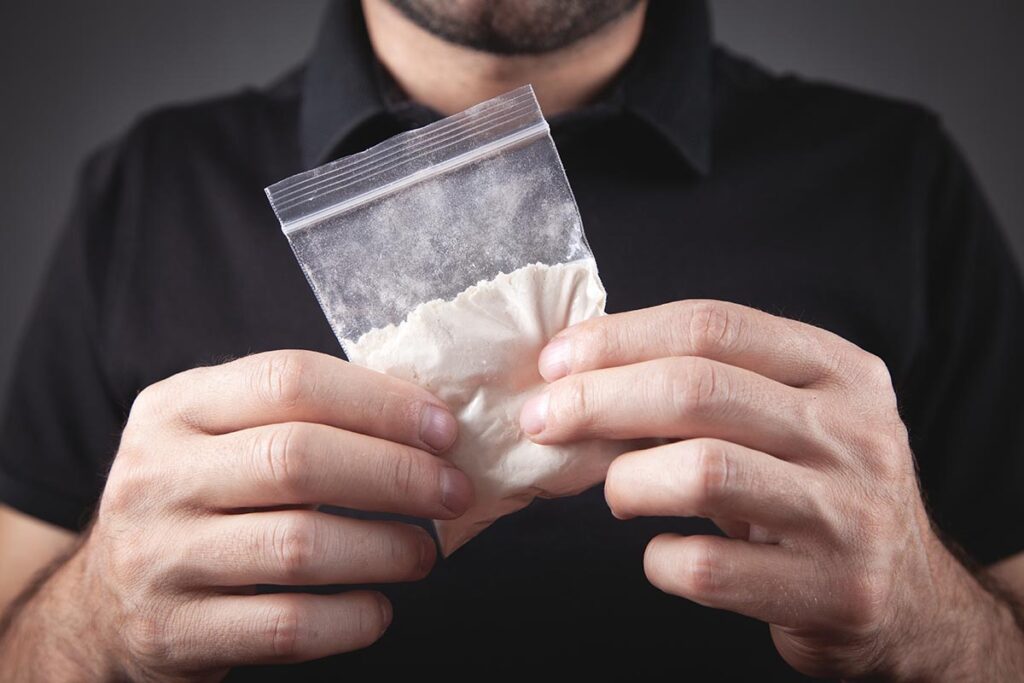The entertainment industry has sensationalized drugs like cocaine for many years. Cocaine has been portrayed as this fine, powdery white substance that is available at parties, clubs, and raves.
Crack cocaine has been shown in movies as a solid white rock form of cocaine, usually available on street corners and for a much cheaper price than cocaine. The reality of what cocaine and crack cocaine look like is somewhat different. There are a number of factors that affect the look or smell of cocaine.
If you suspect that someone you love may be abusing this drug, it is important to know how to identify cocaine so that you are more able to help.
Do you or a loved one need cocaine addiction treatment? Call us today at 844.470.0410 for more information.
How to Identify Cocaine
Regardless of if it comes in a powder or rock form, cocaine tends to be an off-white to pinkish or beige color.
Cocaine is derived from the coca plant, native to South America. The coca plant has to be processed to extract the cocaine from the plant. Usually, solvents or acid are used to remove the cocaine hydrochloride from the leaves.
Cocaine hydrochloride tends to be varying shades of white; but this color can still be different from the cocaine that is sold on the streets.
Many drug dealers add cutting agents to cocaine in order to increase profit or make the cocaine seem more potent than other types of cocaine. This added substance can change the color of cocaine.
Talcum powder or baby laxatives will make cocaine look more white. Other substances, such as powdered caffeine or procaine can change the hue of the drug significantly and make cocaine look less white.
What Does Cocaine Smell Like?
In general, cocaine has a sweet floral scent, but it also smells metallic and chemical-like. This should be no surprise, given the number of chemicals and solvents that are often used in the cocaine extraction process.
Some of the chemicals used to make cocaine and crack cocaine include:
- Carbonate salt
- Kerosene
- Gasoline
- Diesel
- Sulfuric acid
- Caustic soda
- Potassium permanganate
- Ammonia
In addition to the chemical smell of cocaine, many individuals report that crack cocaine smells like burnt plastic or burning rubber when smoked.
What Does Cocaine Taste Like?
The taste of cocaine is often described as bitter. The more bitter tasting the cocaine, the more potent the drug. While cocaine powder is not typically consumed in this manner, people will put cocaine in their mouth to check the purity. Specifically, a person will rub cocaine on their gums when checking purity.
Cocaine that has not been cut will typically numb the gum line when a small amount is rubbed across it. Sometimes the cocaine will be cut with a numbing agent, so the result will be the same and the person may have less pure cocaine without knowing it.
Cocaine Paraphernalia: What To Look For
Because the look of cocaine can vary so much, sometimes a more convenient way to identify cocaine is by the paraphernalia a person will have in their possession.
Cocaine is usually sold in small, resealable plastic bags that are much smaller than the kind available at grocery stores. These bags are often clear or have little designs all over them. Some alternatives to the resealable bags include small brown glass jars or corners of bigger plastic bags that are tied off.
A person who snorts the powder form of cocaine will often have cut off straws, razor blades, and a small mirror. There may also be a powdery residue on flat surfaces.
A person smoking or freebasing cocaine often will have a metal cylinder that has metal wool inside for smoking crack rocks with. They may also use aluminum foil and a lighter to vaporize the freebase version, so there may be burnt pieces of foil laying around.
Injecting cocaine requires another set of paraphernalia. Look for items such as syringes, rubber hoses (for tourniquets), bent spoons and lighters.
Cocaine Addiction Treatment Means Hope for the Future
If you’re struggling with a cocaine addiction, you may feel like there’s no hope. But addiction treatment can help you quit and get your life back on track.
Cocaine is a powerful and addictive drug that affects the brain in many ways. It increases levels of the neurotransmitter dopamine, which is associated with pleasure and motivation. This can lead to compulsive cocaine use, even when it’s harmful to your health and well-being.
Cocaine addiction treatment can help you stop using the drug and get your life back on track. Treatment usually involves a combination of therapy, medication, and support groups. It may also include detoxification, which is the process of getting rid of the drug from your body.
If you’re struggling with a cocaine addiction, don’t give up hope. Treatment can help you overcome your addiction and live a healthy, drug-free life. If you suspect your loved one is addicted to cocaine, or if you, yourself, find yourself unable to control your own cocaine use, there is help available.
At Vertava Health, our cocaine addiction treatment is designed to help people not only quit but also find lasting recovery. Contact us today at 844.470.0410 so we can help you find the best way to help you or your loved one with the addiction battle.


